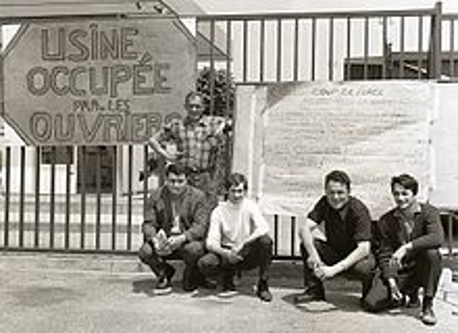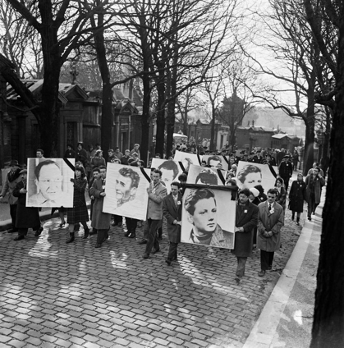Charles de Gaulle: Part 3 – le Chant du Cygne
Who was Charles de Gaulle?

In 1938, Winston Churchill described Russia as, “a riddle, wrapped in a mystery, inside an enigma”. During his long and tempestuous relationship with Charles de Gaulle, Churchill must have thought the same of the General on many occasions.
During his lifetime, de Gaulle had to confront many personal and political crises. Amongst others, he was a POW in the First World War. His daughter was born with Down Syndrome. And the Nazis overran his country.
Most scholars agree that his conduct during three critical periods was the foundation stone to the de Gaulle legacy:
1. his escape to London in 1940,
2. granting Algerian independence in 1962, and
3. the 1968 student riots.
Read Parts: 1, 2, and 3 (this one) of this mini-series in order to discover more details on each of these turning points.
Part 3 – le Chant du Cygne – the swan song
In May 1968, Paris exploded.
Suddenly, out of the blue, there was fighting in the streets. Students were pulling up paving stones to hurl at the police. The workers joined in and a general strike was called. Thousands demonstrated all over France and the protests soon turned to violence.
Riot police were deployed to break up the demonstrators. Barricades were built. Paris became a war zone. In no time at all disorder and confusion had spread throughout l’Hexagone. The dark days were back with a vengeance.

The economy took a nosedive as eleven million French workers went on strike.
The government dithered and then ceased to function. There was talk of revolution and civil war.

Even today, historians have difficulty unraveling what happened next. De Gaulle suddenly disappeared. Even his Prime Minister had no idea where he was. It was later revealed that he’d left the country. He was in Germany, to check on the loyalty of French forces stationed there.

The De Gaulle ‘swan song’
When he returned the next day, he put the army on alert and broadcast to the nation, calling for an election.
He warned that if his proposals were refused, he would resign.
His strategy worked. The public had grown tired of the students and the strikes. 800,000 Gaullist supporters streamed down the Champs Elysées waving the Tricolore. The national student union called off street demonstrations and the barricades were removed. The threat of revolution had passed. France returned to normal, and in the ballot that followed, De Gaulle’s party scored the greatest election win in French history.
However, the demonstrations and strikes tarnished the General’s popularity. Despite his triumph, his proposals for constitutional reform were defeated and he lost the presidential election that followed. A post-crisis survey revealed that a majority of the population saw de Gaulle as old, authoritarian, and vain. Many thought it was time for him to move on.
In France today, May 1968 is still seen as an important turning point in the country’s cultural, social, and political history. The date has gone down as a moral rather than a constitutional revolution. Working conditions, which, in some factories were considered ‘medieval’, were greatly improved, and the minimum wage went up substantially.
Charles De Gaulle retires
In 1969, Charles de Gaulle, true to his word, unceremoniously retired from public life.
Most historians agree that de Gaulle’s most important legacy was his role as leader of the Free French in exile.
During WW2 there is no doubt that France was a nation of collaborators.
In July 1940, the French parliament voted itself out of existence and confirmed Marshal Petain as head of the French Vichy government. Petain signed the Armistice, agreeing that:
All French authorities and officials of the occupied territory, therefore, are to be promptly informed by the French Government to comply with the regulations of the German military commanders and to cooperate with them in a correct manner.
Pétain then accepted Hitler’s invitation to a meeting at Montoire in 1940 and publicly advocated Franco-German ‘collaboration’.
De Gaulle’s position was that Vichy was an illegal government run by traitors and that he, as leader of the Free French government in exile, was the only legitimate head of France.
But after the war, this portrayal of France divided between collaborators and resistants did not suit De Gaulle’s vision for the future of his country. His post-war narrative of France ignored the shame of collaboration. De Gaulle’s enduring image of France became that of a victorious and united country whose untiring efforts eventually prevailed to evict the Nazis.
The CDG legacy
General Charles de Gaulle had a vast army of admirers. But countless Frenchmen (and others, even erstwhile allies) detested him. His legacy as one of the hated figures in French history lives on even today.
But he was undoubtedly one of the political giants of the twentieth century. His legacy in post-war France and his influence on the map of Europe endures. His most lasting contribution domestically was the reform and modernisation of government institutions and streamlining the state.
But the General’s shining contribution to the history of France was keeping the flame of French resistance burning throughout the Nazi occupation. So, finally, it’s hard to quibble with Julian Jackson who ends his astonishing, objective, and monumental biography of de Gaulle with a succinct six-word summary:
He saved the honour of France.
Were you already familiar with the CDG swan song? Share your thoughts in the comments below.
This Series:
Most scholars agree that his conduct during three critical periods was the foundation stone to the de Gaulle legacy:
1. Escape to London in 1940, – Part 1.
2. Granting of Algerian independence in 1962, and – Part 2.
3. the 1968 student riots – Part 3.(this one)
Read Parts 1, and 2 of this mini-series
in order to discover more details on each of these turning points.
On FRANCE 2
they are showing the commencement of the
REPLAY of mini-series ‘Le Grand Charles’.
Le Grand Charles is a 2006 French TV Mini-Series on the life of Charles de Gaulle from 1939 to 1959, written and directed by Bernard Stora.
Source:
Many of the details in this article have been gleaned from Julian Jackson’s monumental 2018 biography ‘Charles de Gaulle’.
Image Credits:
1. Here we drown Algerians via Wikipedia
2. Memorial plaque via Wikipedia
3. Strikers 1968 – Strike poster via Wikipedia
4. Student demonstration via Wikipedia
5. Barricades Bordeauxvia Wikipedia








